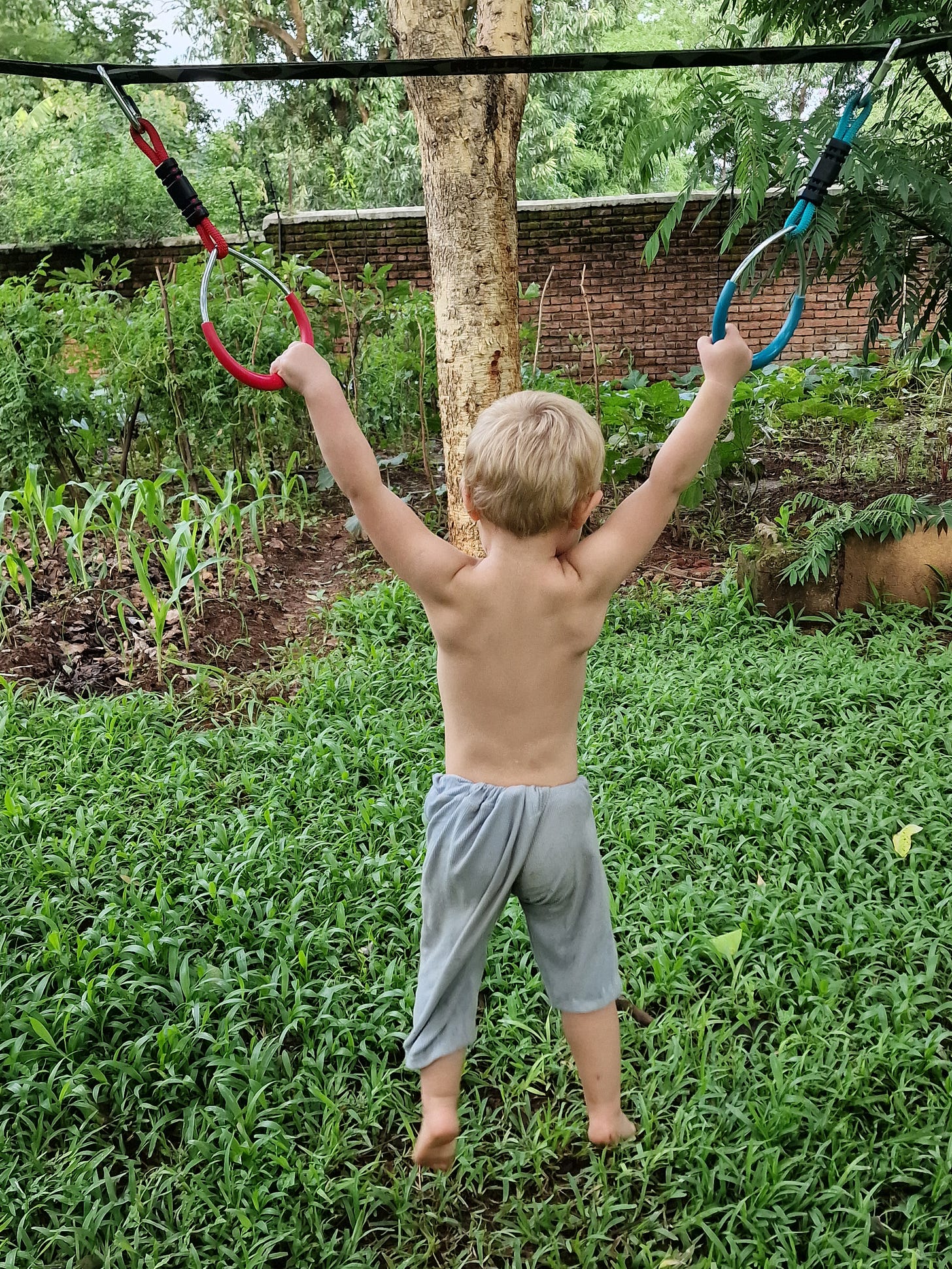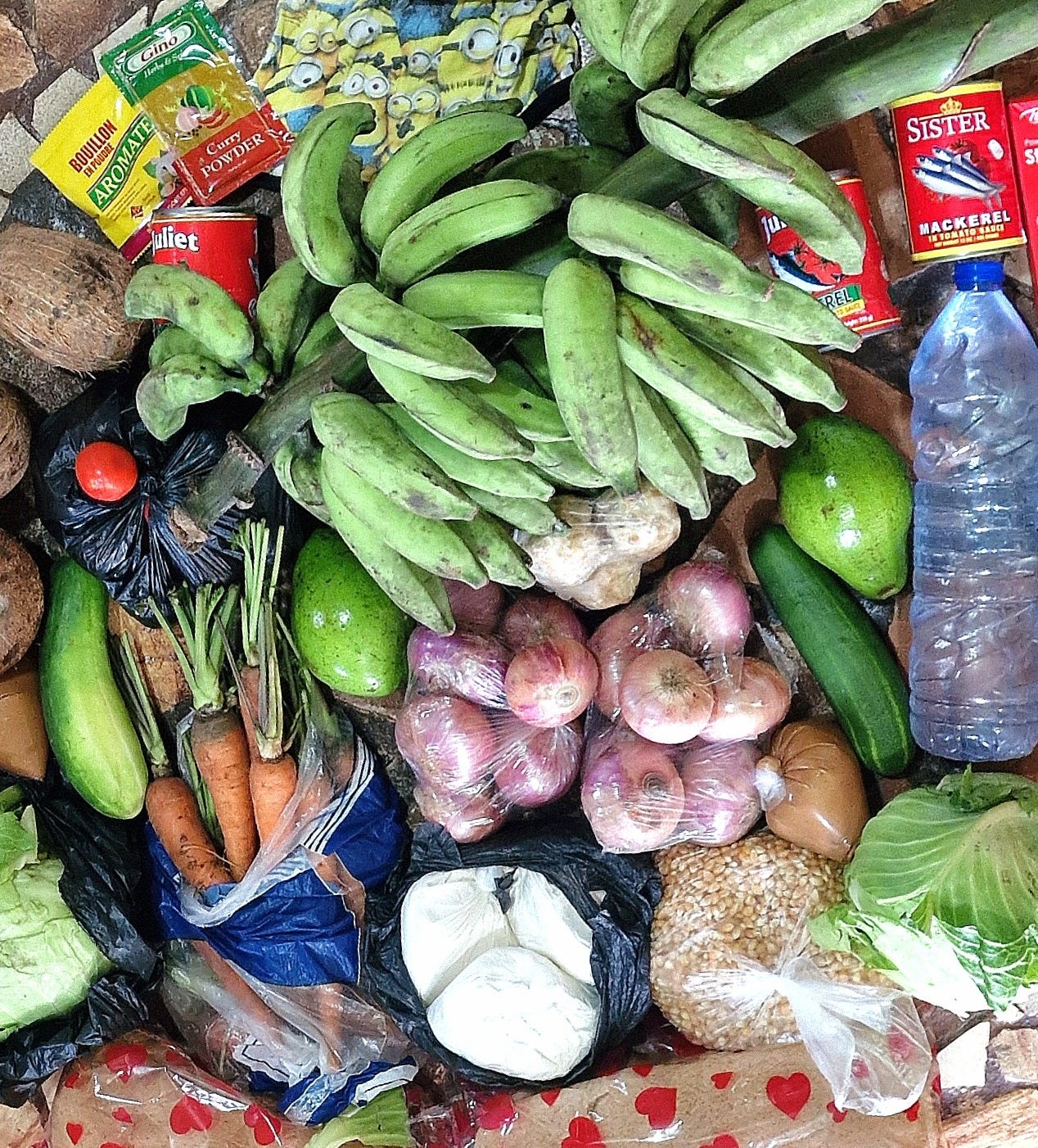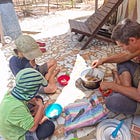Helping children grow guts that work
How to set up a child's gut to work well throughout their life
If I could hold my body absolutely and completely still, I’d be ok, I reasoned. I could handle this. So I hunched myself into a fetal position on the concrete under where I’d slung my hammock immediately after arriving, and I tensed every core muscle I had, and gritted my teeth. But I had a problem: I’d have to breathe. Soon. When they came, my exhalations were half-way between cries and moans. Even when I tried to keep quiet, I couldn’t. The pain was too much.
Lying there, smeared with sweat and grit, desperately wishing for a few more seconds before my next breath, far from Western medical help, I had to face a terrifying truth: I had appendicitis.
Spending 13 hours packed into a miniature bus on punishingly-bumpy jungle roads, folded in half, with two small children on my lap had inflamed my appendix. It was no longer keeping my gut microbes out of my body – its barrier was breaking down. In a last-ditch attempt to save my life, my body was launching an enormous immune response. Billions of white blood cells were pumping out poisons to kill the emerging bacteria before they could start to multiply in my blood. Other immune cells were desperately flooding the area with fluid. My own cells were being caught in the crossfire and having to be replaced or reinforced. My entire body was literally eating itself to provide energy and materials to support the war effort.
I’ve had three children. The pain was far, far worse than childbirth.
While appendicitis is a dramatic example, our guts are famously temperamental. We can (and some of us do) throw all sorts of things at them, until, one day for no apparent reason, we can’t. Or they’ll accept input of any ingredients we can find, but not at any time of day. Or, for some people, regardless of treatment, they hurt and fail to do their function properly.
But…like…it’s a tube, right? An important tube, but a tube nonetheless. How is it that a tube can go wrong? Because it’s a tube that does a job, it’s also a tube with limits.
Those limits are:
Specific parts of the gut are specialized to do specific parts of the digestive process.
These specific parts of the gut can only comfortably hold certain qualities and quantities of stuff while doing so.
The parts of the gut can dial the rate of their specialized functions up or down (a little), but they can’t be done in other places.
Together, these three facts mean that careful control of the location and speed of food in the gut is critical to its effective, comfortable functioning. To that end, it has a complex control and coordination system, which which speeds up or slows down the gut by cross-referencing inputs from:
stretch sensors,
external reflexes
chemical/taste sensors,
and the brain
If any of these aspects are compromised, gut anarchy can result.
What happens when guts don’t function normally?
Gut anarchy? Is it really so bad?
40% of people worldwide (including 14% of children in Europe) suffer from disorders of the gut-brain axis (DGBIs), These include acid reflux, heartburn, abdominal pain, irritable bowel syndrome, bloating, functional constipation or diarrhoea, and more. Historically, we’ve had little explanation for what’s going on. But recently that’s been changing.
DGBIs, or gut anarchy, result from a gut that isn’t moving stuff through it at the right rate.
Doesn’t sound like much? It really is. Because the gut has developed to do specific things in specific places. It pours acid in at the start to kill bacteria, and then neutralises and absorbs it as it leaves the stomach. It pours bile acids in to break up fat globules, and then reabsorbs them. It sticks in a bunch of enzymes to work where the pH is correct. It absorbs various constituents of our food in set regions so they don’t end up further down.
What happens when an anarchic gut hurtles stuff through itself without due respect for its situation?
Catastrophe.
In some places, moving too fast means that too little water is absorbed leading to diarrhoea. In others moving too slowly can leave digestive enzymes working long after they should have been shut down, which can burn the gut wall. Move too slowly in other places and you get constipation. Too fast in other places and you get bacterial overgrowth and pain. The exact location of the mistake dictates the symptoms (and from those we get the name we call that person’s disease: “IBS”, “Acid Reflux”, “Dyspepsia”) but don’t be fooled, the underlying dysfunction is the same.
And that gut anarchy doesn’t just affect our guts. I mentioned DGBIs, right – disorders of the gut–brain axis? These diseases are affected by and affect our bodies in many different ways. Many people with IBS symptoms go on to develop mental health symptoms. And it goes the other way too - psychological symptoms precede the development of IBS in about two-thirds of people. Most of us think of serotonin as a brain chemical, but most of it is produced in our guts, and when our guts aren’t functioning normally, our serotonin system doesn’t work as it should. These DGBIs affect our sleep, our mood, and the pain we experience.
What do guts need to develop normal function?
OK, so we can see that we want to avoid gut anarchy at all costs. How do we create happy regulated guts?
We said that our guts needed to have:
The right level of tension
The right extrinsic reflexes
The right chemical environment
The right input from the brain
Let’s explore this in a bit more detail.
1 - Our guts need the right level of tension
You’ve probably not thought much about how your gut is hung. Let me tell you – it’s far more important that your gut is well-hung than, really, anything else is. Your gut is about 8m long and is suspended from the top of your abdomen by thin membranes that hold it in the perfect position to work without kinking or blocking (these are called mesentery). Your colon has long muscles along it to support it and allow it to squeeze without collapsing (these are called taenia coli). And obviously there’s more – how our guts hang is affected by our whole abdominal cavity – at the front, the position and function of our abdominal muscles, at the top, the position and function of our diaphragm, and at the back, the position and function of our spine. Problems with any of these structures increase our risk that our gut can’t move things through at the right rate, leading to gut anarchy.
So. What does the gut need in order to create strong, sturdy, appropriately formed physical structures?
I talk a lot about the importance of early life movement for creating muscles that are the right length and strength, and bones, joints, and fascia that are the right shape and strength. So, I’ll talk about it here as well. Our spines, diaphragms, and abdominal muscles in adulthood are formed in childhood. To develop normally, they need lots of climbing, hanging, swinging, and upper body movement from a young age and right through childhood.

How about for our mesentery? The mesentery is a connective tissue structure like our tendons and ligaments. Although it’s not been studied, it’s very likely that subjecting it to different mechanical loads increases its strength. We know that mechanical loading is important for guts - when we take it away (for example, if we’re astronauts living in microgravity), we develop IBS. Your mesentery is loaded and unloaded when you move up and down (providing, of course, you’re exposed to the gravity for which we’ve evolved) So I’d prescribe a lot of jumping in childhood. Funnily enough, Nature seems to have made jumping very rewarding for children…
And the taenia coli? These are fascinating and very understudied structures, but likely underlie a lot of our problems with pooping. Children who have ‘bladder and bowel dysfunction’ (problems urinating together with constipation or fecal soiling – bladder and bowel control often go together) are more likely to develop DGBI in adulthood, and this risk is increased for children who don’t defecate every day, who have to push during defecation, and who rarely urinate. But a major risk factor for developing bladder and bowel dysfunction is how you urinate and defecate as a tiny baby.
Apparently, learning to urinate and defecate while being held in a squatting position is important for how the bladder and bowel develop. A recent study found that the risk of bladder and bowel dysfunction is TEN TIMES higher in children that were never held in a squat position. That is a ridiculous difference in risk. We know that children learn much earlier how to empty their bladder when they are held in a squat rather than put in a nappy (average age 9mo vs 3y), and I suspect that the defecation behavioural process has a similar learning requirement.
Have you tried elimination communication? What was your experience? What surprised you about it?
When behaviours are performed frequently at a young age, they can shape the body’s anatomy throughout life. Holding a baby in a squat to defecate means that they never have to push because defecation is easy. It presses the thighs just on the colon, making good bowel movement easier. I suspect that this changes the strength and length of the taenia coli muscles, helping them to move more effectively throughout life and reducing the risk of gut anarchy.
What’s next?
2 - Our guts need the right extrinsic reflexes
It’s easy to overlook our gut’s reflexes, but they’re there all the time, just on the edge of conscious perception. Ever retched after a particularly vicious rollercoaster? Problems with the vestibular system (which controls our ability to balance) can cause diarrhea. People who suffer from problems regulating their blood pressure almost all have gut problems.
So, we need to make sure that the systems driving those reflexes are also healthy. Some aspects we can’t change - how sensitive our nerves, pressure receptors, and vestibular sensors are. However, we can almost always affect how our brains respond to them - and that means lots of challenging those systems in childhood, helping them to develop the right level of calibration so they respond at the right threshold. Most of this is through movement - children, as I’ve said before, need to move as much as possible, in as many different ways as possible.
There are certain diseases that also drive abnormalities in these reflex loops. Let’s focus briefly on two of them - autoimmune diseases affecting nerves (causing conditions like fibromyalgia and postural orthostatic tachycardia syndrome), and inner ear diseases (leading to problems with the balance system).
What can we do to reduce the risk of children ever developing autoimmune diseases? Allergic disease is a major risk factor for autoimmune disease. And we know plenty of things we can do to reduce the risk of allergy:
We can reduce disruption of the surfaces in our body that keep bad stuff out (think avoiding use of soaps and detergents on bodies and things that touch our bodies, think eating diets that support our intestinal barriers, think reducing diaper dermatitis, and more).
We can establish a microbiome that works with, rather than against, our bodies (think home birth, breastfeeding, high-plant diet)
We can introduce allergens at the right time and in the right way (loads to unpick here - it’s all in my book, Growing up WEIRD)
And we can also reduce the risk of damaging a child’s balance system by reducing their risk of inner ear disease. What drives inner ear disease? Several things - some that we can’t change, like our genetics, but some that we can. The big one we can change? Ear infections. Inner ear infections can come from middle ear infections, which arise from viral and bacterial infections from other children. This means the main thing we can do is reduce our child’s likelihood of catching an infection.
We can reduce their exposure to other children. Sometimes this is feasible, often not. I work, and my children go to school and daycare. But don’t panic, there’s more we can do.
We can make them less likely to contract infections they are exposed to - think hand washing, nose hygiene, better ventilation, preventative nasal sprays, and helping them to breathe through their noses - see ‘Breathtaking’ article below.
We can make sure their heads and faces grow in ways that reduce the risk of ear infections. This means prolonged breastfeeding, plenty of chewing, and avoiding prolonged use of things that drive a single mouth movement - like thumbsucking and pacifier use.
There are many things we can do to set up a child’s reflex loops to give their gut the right information. But we also need to make sure the guts have the right stuff going on inside.
3 - Our guts need the right chemical environment
So we’ve not always considered how our guts are hung or their reflexes, but in this day and age pretty much every conversation about our guts mentions our microbiomes. And for good reason: our bugs are essential to our bodies. We rely on our gut microbes for many things – they help us to get more out of our food, they help metabolise some drugs and toxins, they maintain our gut barrier, they modulate our immune systems, and they protect us against pathogens.
Our gut microbiome is so important that humans have even developed an organ whose major function is to store microbes and release them to repopulate our guts after major illnesses. At risk of sounding like clickbait, its identity might surprise you!
The appendix, my would-be assassin, is a narrow tube, filled with gut bacteria. If the gut starts to become inflamed (at the beginning of, say, a bad bout of diarrhoea), the swelling forces the mouth of the tube closed, sealing off a sample of our microbiome in its own little lifeboat. When the inflammation subsides, the tube is reopened and the microbes emerge to repopulate our guts. It's Noah's Ark in miniature.
Apart from Noah's Ark never explodes and kills you.
That terrifying evening in Guyana it hit me first-hand just how risky possessing an appendix can be. Just pause for a second and consider how valuable our microbiomes must be to our health, that evolution thinks it's worth all that risk.
So. What does our gut need to ensure that it’s hosting the right population of inhabitants?
I’m going to go over this only very briefly here – I’ll talk about it more at another time.
But in a nutshell – we need to be colonised by the right bacteria and then we need to maintain them. Colonisation happens in the very early years of childhood. A gut expects to be colonised as its owner travels through their mother’s vagina and vulva, exposing it to her rich and diverse bacteria populations, and to the relaxed, happy environmental flora of the environment in which the gut-owner will grow up. It expects breast milk. It expects weaning onto a diverse diet. It does not expect surgical birth, hospital birth, early-life antibiotics, formula-feeding, added sugar, and kid food.
Maintenance happens from early childhood onwards. The gut expects a diverse, usually plant-rich diet, lots of time outdoors, lots of whole-body movement (especially walking), and lots of good-quality sleep. It does not expect chronic stress, added sugar, ultraprocessed food, low dietary diversity, sedentary lifestyle, antibiotics and preservatives, and disrupted sleep.
When the population is happy and stable, it’s very hard for invaders to take hold, and the whole system functions as it should. When the inhabitants are underfed, overfed, or under attack, they start to revolt. Revolt looks like microbes that start to feed off the gut barrier structures. It looks like microbes that are overwhelmed with food, fermenting too fast and producing too much gas, too much acid, or too much of other signals. It looks like microbes that lose their stable balanced community give-and-take and instead see the growth of a tyrannical local overlord who trashes everything for short-term gain.
When the inhabitants aren’t happy, gut anarchy results.
4 - Our guts need the right input from the brain
If you’ve heard about the microbiome, you may have also heard about the gut–brain axis (or butt-grain axis for reflexive spoonerisers like me). This describes the connections between the gut and the brain – the nerves, the hormones, the immune responses, and other chemicals produced by the microbes. The gut affects the brain and the brain affects the gut.
Brains that aren’t functioning correctly often cause guts not to function correctly. Poor mental health precedes the development of gut problems in many people. Children who’ve suffered hardship or abuse, so-called ‘adverse childhood experiences’ are at higher risk, as are those with anxiety, depression, or PTSD. Chronic stress and sleep disorders also raise the risk. In these conditions, the brain is paying too much or too little attention to the gut system. There’s even a social learning component – children are more likely to develop gut problems if their parents reinforce illness symptoms (by giving the child treats when they are ill), or model illness symptoms (if the parents suffer from gut problems), than if they use distraction techniques if the child feels unwell.
If the brain isn’t giving the right input to the gut, gut anarchy results.
What can we do to set up children to have healthy guts?
Wow. Turns out digestive problems aren’t just in the guts.
To grow children with guts that function normally in adulthood, we need to make sure the physical structures are built correctly, that they are populated with the right inhabitants, and that there is stable, resilient governance.
The right level of tension
Elimination communication or early pottying – These confusing terms describe the process of holding a baby in a squat position when it needs to urinate or defecate. An easy place to start is by just holding the baby in a squat for a minute every time you change the nappy. The baby doesn’t need to go nappy free, but any EC is better than none.
Upper body strength – climbing, hanging, swinging, crawling, carrying, being carried. Child bodies need lots of different types of loads.
Sleeping on hard surfaces to enable the support structures to maintain appropriate movement and flexibility
Avoiding added sugar – this drives fat deposition in the mesentery, which changes its mechanical properties, increasing the risk of gut problems.
The right extrinsic reflexes
Breastfeeding as much as possible for as long as possible – not only for the microbes but also for reducing the risk of ear infections (a common cause of balance abnormalities)
Being chucked around during games with your parents when you’re little – some traditional cultures have ‘being thrown’ as a core movement in exercise routines. These games help to calibrate the balance systems and likely strengthen abdominal support systems.
The right chemical environment
Mode of birth – Babies expect exposure to the right type of maternal microbes and the right type of environmental microbes – there are various ways to make this exposure more likely.
Avoiding early-life antibiotics
Diverse diet – I’ve written before on picky eating and what we can learn from different cultures. Diverse inhabitants need diverse foods. And the more the foods are in their native structures, the more gets down to the colon to feed the microbes.
Avoiding added sugar – good microbes hate sugar.
Spending plenty of time outdoors. Not intuitive – but being outside means you are exposed to many different microbes in the air. You breathe them in, they get stuck in your mucus, you swallow them. Aim to have children outside for at least two hours a day (important for their eyes, also good rule of thumb here), and the more the better.
The right input from the brain
Raising children in an emotionally warm environment reduces most mental health problems and avoids them experiencing so-called ‘Adverse Childhood Experiences.’ However, many things in life can’t be controlled. Fortunately, if the gut is set up well, adverse experiences are much less likely to lead to gut problems
Setting children up for good sleep – I’ll cover this in another article.
Avoiding modelling or reinforcing sickness behaviours – use distraction where possible to help children cope with illness symptoms. Videos are an incredible analgesic and distraction if the child isn’t desensitised to them – keep them in reserve for when you really need them!
None of this would have helped me as I lay dying, curled up on that concrete slab in South America. By the time your gut is so damaged that you’re fighting against the agony of just moving it to take a breath, you needed help days ago, sometimes weeks. But, thanks to the wonders of emergency healthcare, I’m still here to write about it. And thanks to the wonders of modern antibiotics, I even got to keep my appendix. I fought to keep my microbiome lifeboat because I knew how important it would be later in life (and, hey, what’s a little attempted murder between friends?). Alongside my gut stretch sensors, my brain and reflexes, those survivors are going to help me keep everything coordinated for the rest of my life.
You might also like:
Notes
Functional digestive disorders in European kids - 11% in children aged 4–18 years: https://onlinelibrary.wiley.com/doi/full/10.1002/jpn3.12437
Early life exposures that increase your risk of IBS: https://pmc.ncbi.nlm.nih.gov/articles/PMC10507713/
Childhood bladder and bowel dysfunction and later IBS development: https://pmc.ncbi.nlm.nih.gov/articles/PMC5542834/
Elimination communication and childhood bladder and bowel dysfunction - “Additionally, the prevalence among children who started EC within 12 months after birth and those who never engaged in EC was 1.36% and 15.71% respectively.” https://www.nature.com/articles/s41598-021-91704-3
Learning to empty the bladder with elimination communication: https://pubmed.ncbi.nlm.nih.gov/23759503/
Social learning and parental modelling of illness behaviour and risk of childhood gut problems: https://pmc.ncbi.nlm.nih.gov/articles/PMC4146756/
Breastfeeding and ear infections - https://journals.iarn.or.id/index.php/HealMed/article/view/263
Mouth breathing and ear infections - https://www.sciencedirect.com/science/article/abs/pii/S0165587618300387
Sedentary behaviour is associated with a higher risk of most gastrointestinal diseases https://www.thelancet.com/journals/ebiom/article/PIIS2352-3964(24)00145-2/fulltext












Wow! I had to stop reading this to learn about astronauts and Ibs! I never thought about that before, thank you for your interesting articles.
Don’t have my own children, but have nannied extensively, and practicing EC is hard for me NOT to practice with any infant I’m working with! Love finding new studies that support the benefits of EC, thanks for sharing.
I’m curious about this one, where you say, “A recent study found that the risk of bladder and bowel dysfunction is TEN TIMES higher in children that were never held in a squat position.”
Looking through the citations you listed in this article, I can’t find where that fact is mentioned, but I’m also not particularly well practiced in reading scientific studies all that well when there’s lots of jargon, so maybe I’m just missing it? Could you point me in the right direction? It’s something I’d love to share with parents who are curious about EC.